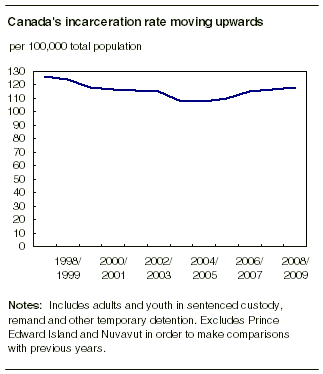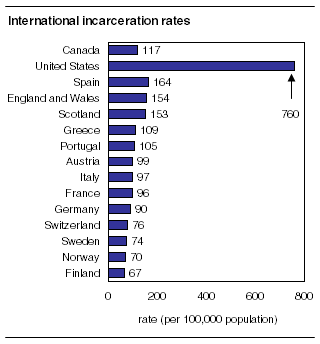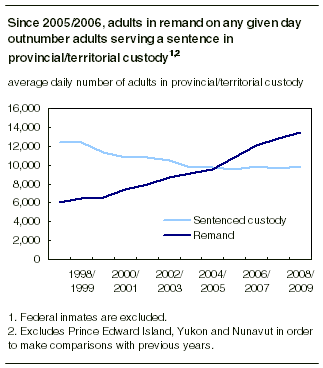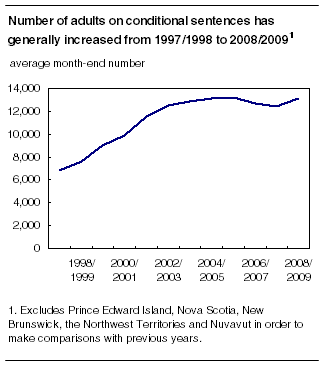Common menu bar links
Adult and youth correctional services: Key indicators
Archived Content
Information identified as archived is provided for reference, research or recordkeeping purposes. It is not subject to the Government of Canada Web Standards and has not been altered or updated since it was archived. Please "contact us" to request a format other than those available.
In 2008/2009, Canada's incarceration rate increased 1% over the previous year, driven largely by the continued increase in the number of adults held in remand in provincial/territorial jails while awaiting trial or sentencing.

Correction: On any given day in 2008/2009, an average of 37,201 adults and 1,898 youth aged 12 to 17 were in custody in Canada, for a total of 39,098 inmates. This resulted in an incarceration rate of 117 people in custody for every 100,000 people in Canada.
It was the fourth consecutive annual increase in the incarceration rate. The four increases followed a decade of steady declines attributable to a decrease in the number of youth and federal offenders held in custody.
Canada's incarceration rate has tended to be higher than those in most Western European countries, yet far lower than that of the United States.
Note to readers
Data in this release were collected by the Corrections Key Indicator Report (CKIR) survey for adults and youth. Data are based on daily counts of adults and youth in custodial facilities and monthly counts of offenders under community supervision. These data are collected by correctional officials and reported to Statistics Canada by way of the CKIR. Data are reported on a fiscal year basis, which spans from April 1 to March 31.
Offenders who serve a sentence of less than two years are the responsibility of provincial and territorial governments, as are those held in remand (that is, in custody awaiting trial or sentencing) or other temporary detention (e.g., immigration hold). Incarcerated people are those serving a custodial sentence and those in remand or other temporary detention. Adults serving a conditional sentence are not considered to be incarcerated.
The total incarceration rate is the average daily number of all incarcerated adults and youth for every 100,000 people in the total population. It is an internationally recognized measure commonly used to provide information about trends in imprisonment and to make comparisons among countries regarding the use of custody. When speaking of adults and youth separately, rates are based on 100,000 adults aged 18 and older and 10,000 youth aged 12 to 17.
The analysis of long-term trends for the overall incarceration rate and adult custody excludes Prince Edward Island and Nunavut as a result of missing data for certain years.
References to incarceration rates from countries other than Canada are based on data from World Prison Brief, prepared by King's College London. The rate for Canada is based on data for the fiscal year 2008/2009, and the rate for the United States is based on the calendar year 2008 and excludes youth. The data for other countries are based on the most recent data published by World Prison Brief, and reference years range from between 2008 and 2009. These rates are based on each country's total population and include, with the exception of the United States, the total number of adults and youth in custody. In Canada, a youth is considered to be aged between 12 and 17. The definition of youth may vary from one country to another.
The analysis of long-term trends in counts of adults in the community serving conditional sentences excludes Prince Edward Island, Nova Scotia, New Brunswick, the Northwest Territories and Nunavut as a result of missing data for certain years.

Upward trend of adults held while awaiting trial or sentencing continues
On any given day in 2008/2009, just over 13,500 adults were being held in remand, up 4% from the previous year. This continued an upward trend that began in the mid-1990s. The number of adults held in remand has doubled during the past decade.
All provinces and territories, except Prince Edward Island and Quebec, contributed to the increase in remanded adults in 2008/2009.
The more than 13,500 adults held in remand outnumbered the roughly 10,000 adults who were serving a sentence in a provincial or territorial jail.

On the whole, adults held in remand have outnumbered those serving a provincial/territorial sentence at the national level since 2005/2006. However, this was not the case in all provinces and territories. In 2008/2009, 57% of adults held in provincial/territorial custody were in remand. Remanded inmates outnumbered sentenced inmates in Nova Scotia, Ontario, Manitoba, Alberta and British Columbia.
Number of adults in federal prisons remains stable
After rising for four consecutive years, the number of offenders in federal prisons on any given day remained stable in 2008/2009 at about 13,300.
Federal offenders, those serving sentences of two years or more, continued to account for about 4 in 10 adults in custody.
Adults serving conditional sentences in the community on the rise
Correction: At the end of any given month in 2008/2009, there were 13,506 adults serving a conditional sentence in the community, up 5% from the previous year.
Since the introduction of this sentencing option in 1996, the average number of adults serving a conditional sentence has increased annually, except in 2006/2007 and 2007/2008.

A conditional sentence is a sentence of less than two years that is served in the community and can be subject to strict conditions. Upon breach of these conditions, the remainder of the sentence could be served in custody. Since conditional sentences are served in the community, they are not included in the incarceration rates.
Number of youth in sentenced custody continues to decrease
On any given day in 2008/2009, 899 youth aged 12 to 17 were in sentenced custody, down 8% from the previous year and 42% from 2003/2004, the year the Youth Criminal Justice Act (YCJA) was introduced.
The YCJA was intended in part to serve as a means to divert youth who commit non-violent and minor offences away from the court system through the use of extrajudicial measures. Examples of such measures include police warnings, referrals to community programs and Crown cautions.
The greatest decrease in the number of youth in sentenced custody occurred in 2003/2004. However, the number had been declining annually since 1995/1996.
Youth in remand outnumber those in sentenced custody
The number of youth held in remand while awaiting trial or sentencing declined 3% to 981 in 2008/2009, the first drop in three years. Despite this decline, youth in remand outnumbered those being held in sentenced custody for the second consecutive year.
In 2008/2009, 52% of all young people held in custody on any given day were in remand.
At the end of any given month in 2008/2009, 18,012 youth were on probation. Young people on probation continued to account for the majority of youth under correctional supervision, and the number remained stable from the previous year.
Available on CANSIM: tables 251-0004 to 251-0006 and 251-0008.
Definitions, data sources and methods: survey number 3313.
For more information, or to enquire about the concepts, methods or data quality of this release, contact Information and Client Services (toll-free 1-800-387-2231; 613-951-9023; fax: 613-951-6615), Canadian Centre for Justice Statistics.
Table 1
| 2008/2009 | 2007/2008 to 2008/2009 | 2008/2009 | 2007/2008 to 2008/2009 | 2008/2009 | 2007/2008 to 2008/2009 | ||
|---|---|---|---|---|---|---|---|
| Sentenced custody | Remand | Total actual-in count1 | Adult incarceration rate | ||||
| number | % change | number | % change | number | per 100,000 adults | % change | |
| Newfoundland and Labrador | 186 | -7 | 96 | 20 | 282 | 68 | 0 |
| Prince Edward Island | 71 | -18 | 16 | 0 | 92 | 83 | -15 |
| Nova Scotia | 180 | 4 | 240 | 7 | 449 | 59 | 5 |
| New Brunswick | 278 | 14 | 133 | 4 | 431 | 71 | 9 |
| Quebec | 2,466 | 3 | 2,021 | -1 | 4,486 | 72 | 0 |
| Ontario | 2,802 | -4 | 5,809 | 3 | 8,855 | 87 | -1 |
| Manitoba | 510 | 4 | 1,133 | 6 | 1,642 | 177 | 4 |
| Saskatchewan | 869 | 7 | 573 | 4 | 1,453 | 187 | 4 |
| Alberta (correction) | 1,089 | 8 | 1,796 | 8 | 2,885 | 104 | 5 |
| British Columbia | 1,234 | 1 | 1,546 | 9 | 2,809 | 80 | 3 |
| Yukon | 31 | 13 | .. | .. | 79 | 303 | 10 |
| Northwest Territories2 | 171 | 4 | 92 | 16 | 264 | 843 | 8 |
| Nunavut | 78 | .. | 53 | .. | 131 | 684 | .. |
| Federal | 13,343 | 0 | .. | .. | 13,343 | 51 | -1 |
| Total (correction)3 | 23,307 | 1 | 13,507 | 4 | 37,201 | 141 | 1 |
Table 2
| 2008/2009 | 2007/2008 to 2008/2009 | 2008/2009 | 2007/2008 to 2008/2009 | 2008/2009 | 2007/2008 to 2008/2009 | ||
|---|---|---|---|---|---|---|---|
| Sentenced custody | Remand | Total actual-in count1 | Youth incarceration rate | ||||
| number | % change | number | % change | number | per 10,000 youth aged 12 to 17 | % change | |
| Newfoundland and Labrador | 21 | -15 | 6 | -18 | 27 | 7 | -13 |
| Prince Edward Island | 6 | -12 | 1 | -25 | 7 | 6 | -12 |
| Nova Scotia | 31 | -24 | 25 | -12 | 60 | 9 | -14 |
| New Brunswick | 38 | 2 | 14 | -9 | 53 | 10 | 0 |
| Quebec | 137 | -1 | 80 | 8 | 217 | 4 | 4 |
| Ontario | 285 | -20 | 411 | -8 | 696 | 7 | -12 |
| Manitoba | 82 | 4 | 176 | 8 | 270 | 26 | 6 |
| Saskatchewan | 141 | 5 | 89 | -7 | 230 | 26 | 2 |
| Alberta | 80 | -7 | 99 | -1 | 179 | 6 | -3 |
| British Columbia | 64 | -1 | 74 | 3 | 138 | 4 | 2 |
| Yukon | 2 | 27 | 2 | -11 | 4 | 16 | 13 |
| Northwest Territories | 10 | 6 | 5 | -12 | 15 | 35 | 0 |
| Nunavut | .. | .. | .. | .. | .. | .. | .. |
| Total2 | 899 | -8 | 981 | -3 | 1,898 | 7 | -4 |

